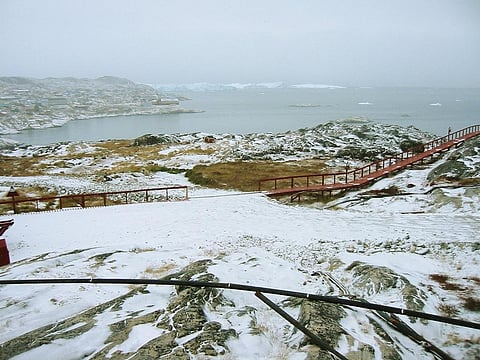CoP 26: Greening of polar ice should top agenda; here’s why
Climate change is unequivocal and has caused unprecedented changes to the world’s atmosphere. It affects the polar ice caps that are the thermostats of the planet with their high albedo.
Albedo of a surface is the fraction of sunlight it reflects back. Greening will convert the ‘net reflective’ ice caps to ‘net absorptive’, tampering with the global energy balance and accelerate polar ice melting.
It is evident from the sixth assessment report of the Intergovernmental Panel on Climate Change (IPCC) that the primary reason for every possible cause of global warming is anthropogenic, which has caused the world to heat up beyond 1.1 degree Celsius above the pre-industrial levels.
However, this pattern of warming isn’t equitably felt throughout the world. For the past several decades, the Arctic has been warming twice as quickly as the rest of the world and undergoing tremendous transformation.
Arctic Sea ice reduced by around 39 per cent in the last 38 years, according to the National Snow and Ice Data Centre. Over the same period, ice in Antarctica also reduced by 6.2 per cent, a recent paper published in the Proceedings of the National Academy of Sciences of the United States of America showed.
Researchers at National Aeronautics and Space Administration, using 29 years of data from Landsat satellites, have observed extensive greening around Alaska and Canada, which were snow-covered lands.
This is occurring because Arctic summers are getting warmer every decade and this can be clearly explained by the positive feedback loop.
Sea ice has a bright surface — about 80 per cent of the sunlight that strikes it is reflected into space. The sea ice melts and exposes the deep, dark ocean water because of rising temperatures.
Now, instead of reflecting 80 per cent of the sunlight, the ocean absorbs 90 per cent of the solar radiation. The seawater heats up and Arctic temperatures rise further, amplifying the rate of warming.
The region, as a result, turns greener with the habitable climate provided by warmer air and soil temperatures. Rapidly rising temperatures in the Arctic have led to longer growing seasons and shifting soils for the plants.
Scientists have observed the grassy tundra transitioning to scrublands and shrubs becoming larger and denser. The Arctic faced several other adverse impacts in its zone because of climate-induced greening.
The Caribou (reindeer) populations declined with the increased growth of summer pastures. A change in the shrub pattern was noticed: Many non-edible shrubs grew, which eventually led to the disappearance of the Caribou herds from the region, threatening the biodiversity of the region.
The Antarctic is also equally greening because of the irreversible melting of sea ice, which is green in colour.
In 2016, it was discovered that marine ice has 500 times more iron than the ice above it. This iron comes from the rocks under the Antarctic ice sheet which, when glaciers pass over them, are ground into a fine powder. The ice-bound iron oxidizes in contact with seawater.
The resulting iron oxide particles take on a green hue as light scatters through them. The green ice only becomes visible when an iceberg capsizes and flips over from excessive melting and is disjointed from the main body.
It is, therefore, also a consequence of global warming. Despite several underpinnings, is it still being discussed as the primary cause of climate change in the 26th Conference of Parties (CoP26) to the United Nations Framework Convention on Climate Change?
Rapidly melting permafrost in the poles is also releasing trapped greenhouse gases like methane into the atmosphere. Thawing of permafrost is releasing ancient methane in places like Siberia, which can turn the coldest place on earth into a temperate zone.
This is precisely why the IPCC report also said that the world must also deliver rapid and drastic reductions in methane emissions, in addition to slashing carbon dioxide emissions, to mitigate the climate crisis.
The reasons discussed above are why the greening of poles cannot be dismissed or ignored. It should be at the top of the agenda for the upcoming CoP26 in Glasgow to be held in November for every leader of every country.
Full coverage: What to expect from COP26
This year's conference will be a platform for countries to revise their emission-reduction goals since the Paris agreement 2015. The latter fell short of reducing global warming to 1.5°C by 2030.
So, CoP26 will be a crucial determinant of climate agreements in the coming decades.
The world is in unpredictable turmoil trying to tackle its challenges after the novel coronavirus disease (COVID-19) pandemic that has disrupted several global economies.
In this period, instead of rushing into business as usual, the primary investments that are to be made by these world leaders ought to be climate-conscious to determine a low-carbon future.
The IPCC reports have already dropped the hint that achieving the famous Paris Agreement 2015 standards will be highly unlikely. So, rather than looking at profitable goals, we should try to focus on the shift to sustainable standards of development in the economies.
Climate change risks also give rise to several geopolitical problems:
- Energy scarcity
- Rising sea levels
- Opening of new trade and shipping routes and expanding oil drilling
- Rise of climate refugees
All of these are geopolitical and diplomatic issues. So, they can only be addressed in international forums like CoP26.
The effects of climate change (greening of the poles) are transboundary in nature. Thus, it is reasonable to assume that the only solution could be integrated international negotiations and frameworks.
These are required to set standards for nations and businesses to achieve global average temperature standards at the earliest, before the warming crosses the tipping point.
Views expressed are the author’s own and don’t necessarily reflect those of Down To Earth.

